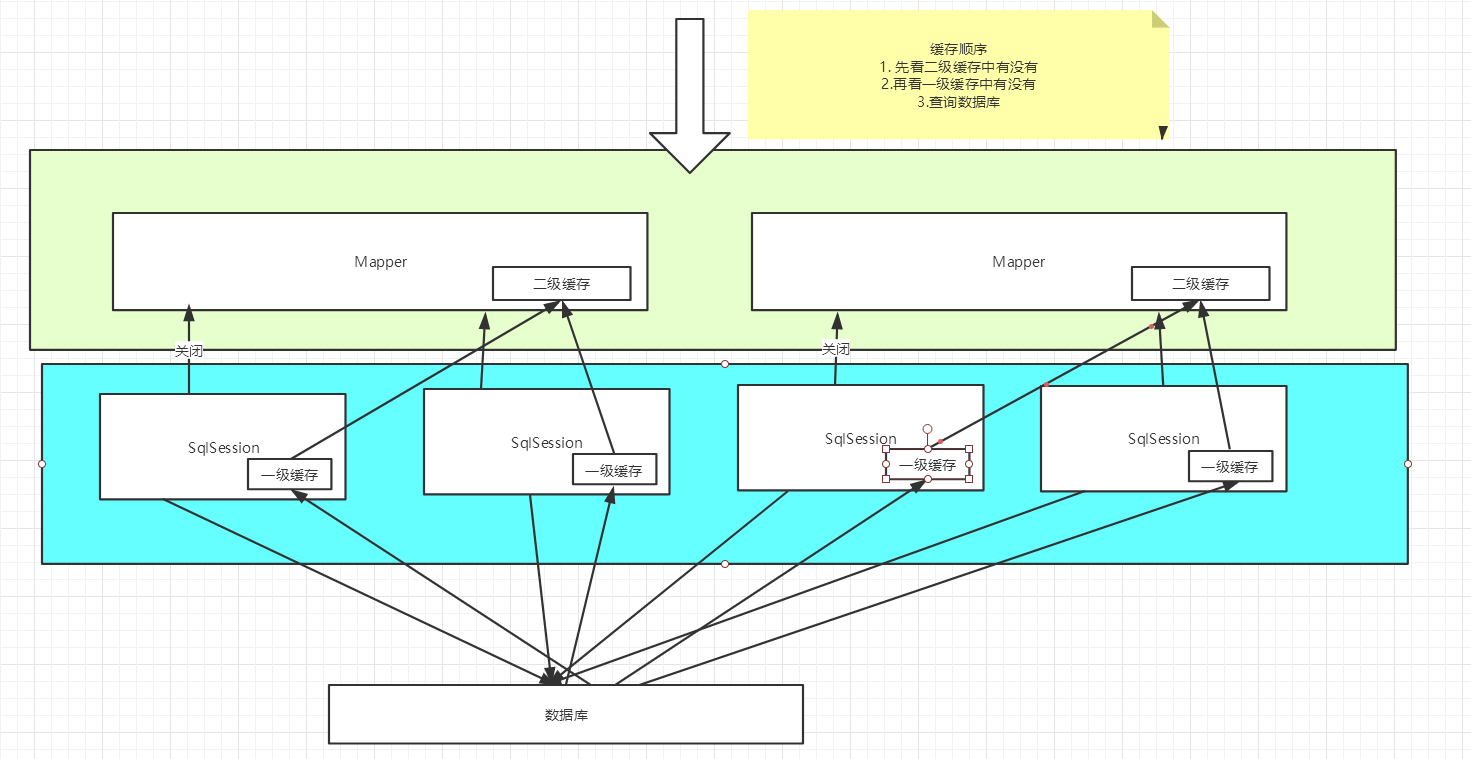MyBatis自学之路
1 Mybatis简介
1.1 mybatis是什么?
- MyBatis 是一款优秀的持久层框架,它支持自定义 SQL、存储过程以及高级映射。MyBatis 免除了几乎所有的 JDBC 代码以及设置参数和获取结果集的工作。MyBatis 可以通过简单的 XML 或注解来配置和映射原始类型、接口和 Java POJO(Plain Old Java Objects,普通老式 Java 对象)为数据库中的记录。
- MyBatis 本是apache的一个开源项目iBatis, 2010年这个项目由apache software foundation 迁移到了google code,并且改名为MyBatis 。2013年11月迁移到Github。
1.2 myBatis优点
- 简单易学:本身就很小且简单。没有任何第三方依赖,最简单安装只要两个jar文件+配置几个sql映射文件易于学习,易于使用,通过文档和源代码,可以比较完全的掌握它的设计思路和实现。
- 灵活:mybatis不会对应用程序或者数据库的现有设计强加任何影响。 sql写在xml里,便于统一管理和优化。通过sql语句可以满足操作数据库的所有需求。
- 解除sql与程序代码的耦合:通过提供DAO层,将业务逻辑和数据访问逻辑分离,使系统的设计更清晰,更易维护,更易单元测试。sql和代码的分离,提高了可维护性。
- 提供映射标签,支持对象与数据库的orm字段关系映射
- 提供对象关系映射标签,支持对象关系组建维护
- 提供xml标签,支持编写动态sql
1.3 持久化
数据持久化
- 持久化就是将程序的数据在持久状态和瞬时状态转化的过程
- 内存:断电即失
- 数据库(Jdbc),io文件持久化。
1.4 持久层
Dao层、Service层、Controller层
- 完成持久化工作的代码块
- 层界限十分明显
技术没有高低之分,只有使用技术的人有高低之分
2 Mybatis第一个程序
2.1 环境搭建
-
准备数据库
create database mybatis; use mybatis; create table user( id int(10) primary key, `name` varchar(30), `password` varchar(30) )engine=INNODB default charset = utf8; insert into user values (1,'zhangsan','123'), (2,'lisi','123'), (3,'wangwu','123'); -
添加环境依赖并创建子模块
<dependencies> <!-- https://mvnrepository.com/artifact/org.mybatis/mybatis --> <dependency> <groupId>org.mybatis</groupId> <artifactId>mybatis</artifactId> <version>3.4.6</version> </dependency> <dependency> <groupId>mysql</groupId> <artifactId>mysql-connector-java</artifactId> <version>5.1.47</version> </dependency> <dependency> <groupId>junit</groupId> <artifactId>junit</artifactId> <version>4.13</version> <scope>test</scope> </dependency> </dependencies> -
从 XML 中构建 SqlSessionFactory
-
每个基于 MyBatis 的应用都是以一个 SqlSessionFactory 的实例为核心的。SqlSessionFactory 的实例可以通过 SqlSessionFactoryBuilder 获得。而 SqlSessionFactoryBuilder 则可以从 XML 配置文件或一个预先配置的 Configuration 实例来构建出 SqlSessionFactory 实例。
-
创建mybatis-configuration.xml
<?xml version="1.0" encoding="UTF-8" ?> <!DOCTYPE configuration PUBLIC "-//mybatis.org//DTD Config 3.0//EN" "http://mybatis.org/dtd/mybatis-3-config.dtd"> <configuration> <environments default="development"> <environment id="development"> <transactionManager type="JDBC"/> <dataSource type="POOLED"> <property name="driver" value="com.mysql.jdbc.Driver"/> <property name="url" value="jdbc:mysql://localhost:3306/mybatis?useSSL=true&characterEncoding=utf-8&useUnicode=true"/> <property name="username" value="root"/> <property name="password" value="123456"/> </dataSource> </environment> </environments> <mappers> <mapper resource="org/mybatis/example/BlogMapper.xml"/> </mappers> </configuration> -
创建MybatisUtil工具类
public class MybatisUtil { //创建SqlSessionFactory实例 private static SqlSessionFactory sqlSessionFactory = null; static { String resource = "mybatis-configuration.xml"; SqlSessionFactoryBuilder factoryBuilder = new SqlSessionFactoryBuilder(); try { sqlSessionFactory = factoryBuilder.build(Resources.getResourceAsStream(resource)); } catch (IOException e) { e.printStackTrace(); } } //既然有了 SqlSessionFactory,顾名思义,我们可以从中获得 SqlSession 的实例. // SqlSession 提供了在数据库执行 SQL 命令所需的所有方法。 public static SqlSession getSqlSession(){ return sqlSessionFactory.openSession(); } }
-
2.2 编写查询语句代码
-
准备实体类User
-
编写dao接口
public interface UserDao { List<User> getUserList(); } -
编写dao接口对应的mapper.xml配置文件
<!DOCTYPE mapper PUBLIC "-//mybatis.org//DTD Mapper 3.0//EN" "http://mybatis.org/dtd/mybatis-3-mapper.dtd"> <!--namespace 对应的 dao接口 id 方法名, 返回值的类型:填写list中传入的泛型--> <mapper namespace="com.iandf.dao.UserDao"> <select id="getUserList" resultType="com.iandf.pojo.User"> select * from mybatis.user </select> </mapper> -
添加pom.xml添加配置,防止java目录下的资源配置文件导出失败
<build> <resources> <resource> <directory>src/main/java</directory> <includes> <include>**/*.xml</include> <include>**/*.properties</include> </includes> <filtering>true</filtering> </resource> </resources> </build> -
使用junit测试
@org.junit.Test public void Test(){ SqlSession sqlSession = MybatisUtil.getSqlSession(); UserDao mapper = sqlSession.getMapper(UserDao.class); List<User> userList = mapper.getUserList(); for (User user : userList) { System.out.println(user.toString()); } }
2.3 遇到的错误
1. 类找不到,在终端执行 mvn idea:idea指令之后就能解决
2. 配置文件mybatis-configuration.xml找不到,没有配置mapper 或者 resources文件夹没有被标记为资源文件夹
2.4 CRUD
-
UserMapper接口类
public interface UserMapper { List<User> getUserList(); //insert int addUser(User user); //delete int deleteUserById(int id); //update int updateUserById(User user); //select User queryUserById(int id); } -
mapper.xml配置文件
<mapper namespace="com.iandf.dao.UserMapper"> <select id="getUserList" resultType="com.iandf.pojo.User"> select * from mybatis.user </select> <insert id="addUser" parameterType="com.iandf.pojo.User"> # #{user.id}也可以省去对象名称 insert into mybatis.user(id, name, password) VALUES (#{user.id},#{name},#{password}) </insert> <delete id="deleteUserById" parameterType="int"> delete from mybatis.user where id = #{id} </delete> <update id="updateUserById" parameterType="com.iandf.pojo.User"> update mybatis.user set name = #{name},password = #{password} where id = #{id} </update> <select id="queryUserById" parameterType="int" resultType="com.iandf.pojo.User"> select * from mybatis.user where id = #{id} </select> </mapper> -
测试文件
@Test public void deleteUserByIdTest(){ SqlSession sqlSession = MybatisUtil.getSqlSession(); UserMapper mapper = sqlSession.getMapper(UserMapper.class); int nums = mapper.deleteUserById(4); System.out.println(nums); sqlSession.commit(); } @Test public void queryUserByIdTest(){ try(SqlSession sqlSession = MybatisUtil.getSqlSession()) { UserMapper mapper = sqlSession.getMapper(UserMapper.class); User user = mapper.queryUserById(4); System.out.println(user.toString()); } }
note:
1. 增删改需要提交事务
2. sqlSession相当于connection mapper相当于statement
3. #{xxx} xxx必须与编写的字段和参数名相同
2.5 使用万能的map传递参数
使用map插入一条记录
-
dao接口
int addUserByMap(Map<String,Object> map); -
mapper.xml
<insert id="addUserByMap" parameterType="map"> insert into mybatis.user(id, name, password) VALUES (#{userID},#{userName},#{UserPassword}) </insert> -
测试案例
@Test public void addUserTestByMap(){ try(SqlSession sqlSession = MybatisUtil.getSqlSession()){ UserMapper mapper = sqlSession.getMapper(UserMapper.class); HashMap<String, Object> map = new HashMap<>(); map.put("userID",5); map.put("userName","王五"); map.put("UserPassword","123456"); mapper.addUserByMap(map); sqlSession.commit(); } }
NOTE:
- 传递多个参数可以使用对象,也可以使用map
- 传递一个参数,直接使用方法形参即可
2.6 模糊查询
-
在传递参数时使用通配符,在sql语句中写死
-
mapper.xml
<select id="queryUserByLikeName" resultType="com.iandf.pojo.User"> select * from mybatis.user where name like #{value} </select> -
dao接口和测试代码
//select List<User> queryUserByLikeName(String value); @Test public void queryUserByLikeNameTest(){ try(SqlSession sqlSession = MybatisUtil.getSqlSession()) { UserMapper mapper = sqlSession.getMapper(UserMapper.class); List<User> users = mapper.queryUserByLikeName("%n%"); for (User user : users) { System.out.println(user.toString()); } } }
-
-
在sql语句中进行拼接,传递参数时只需要传用户输入部分,这样sql在进行拼接,容易导致sql注入
-
mapper.xml
<select id="queryUserByLikeName2" parameterType="String" resultType="com.iandf.pojo.User"> select * from mybatis.user where name like "%"#{value}"%" </select> -
dao接口和测试代码
List<User> queryUserByLikeName2(String value); @Test public void queryUserByLikeName2Test(){ try(SqlSession sqlSession = MybatisUtil.getSqlSession()) { UserMapper mapper = sqlSession.getMapper(UserMapper.class); List<User> users = mapper.queryUserByLikeName2("n"); for (User user : users) { System.out.println(user.toString()); } } }
-
3 配置解析
3.1 核心配置文件
Mybatis的配置文件包含了会深深影响MyBatis行为的设置和属性信息。
configuration(配置)
properties(属性)
settings(设置)
typeAliases(类型别名)
typeHandlers(类型处理器)
objectFactory(对象工厂)
plugins(插件)
environments(环境配置)
environment(环境变量)
transactionManager(事务管理器)
dataSource(数据源)
databaseIdProvider(数据库厂商标识)
mappers(映射器)
3.2 环境配置 environments
MyBatis 可以配置成适应多种环境
不过要记住:尽管可以配置多个环境,但每个 SqlSessionFactory 实例只能选择一种环境
MyBatis默认的事务管理器就是JDBC ,连接池:POOLED
3.3 属性 properties
我们可以通过properties属性来实现引用配置文件
这些属性可以在外部进行配置,并可以进行动态替换。你既可以在典型的 Java 属性文件中配置这些属性,也可以在 properties 元素的子元素中设置。【db.poperties】
-
编写一个配置文件
db.properties
driver=com.mysql.cj.jdbc.Driver url=jdbc:mysql://localhost:3306/mybatis?userSSL=true&useUnicode=true&characterEncoding=UTF-8&serverTimezone=UTC username=root password=root 1234 -
在核心配置文件中引入
<!--引用外部配置文件--> <properties resource="db.properties"> <property name="username" value="root"/> <property name="password" value="root"/> </properties> 12345- 可以直接引入外部文件
- 可以在其中增加一些属性配置
- 如果两个文件有同一个字段,优先使用外部配置文件的
3.4 类型别名 typeAliases
- 类型别名可为 Java 类型设置一个缩写名字。 它仅用于 XML 配置.
- 意在降低冗余的全限定类名书写。
<!--可以给实体类起别名-->
<typeAliases>
<typeAlias type="com.kuang.pojo.User" alias="User"/>
</typeAliases>
也可以指定一个包,每一个在包 domain.blog 中的 Java Bean,在没有注解的情况下,会使用 Bean 的首字母小写的非限定类名来作为它的别名。 比如 domain.blog.Author 的别名为 author,;若有注解,则别名为其注解值。见下面的例子:
<typeAliases>
<package name="com.kuang.pojo"/>
</typeAliases>
在实体类比较少的时候,使用第一种方式。如果实体类十分多,建议用第二种扫描包的方式。
第一种可以DIY别名,第二种不行,如果非要改,需要在实体上增加注解。
@Alias("author")
public class Author {
...
}
3.5 映射器 mappers
MapperRegistry:注册绑定我们的Mapper文件;
方式一:【推荐使用】
<!--每一个Mapper.xml都需要在MyBatis核心配置文件中注册-->
<mappers>
<mapper resource="com/kuang/dao/UserMapper.xml"/>
</mappers>
1234
方式二:使用class文件绑定注册
<!--每一个Mapper.xml都需要在MyBatis核心配置文件中注册-->
<mappers>
<mapper class="com.kuang.dao.UserMapper"/>
</mappers>
方式三:使用包扫描进行注入
<mappers>
<package name="com.kuang.dao"/>
</mappers>
方法二和方法三的注意点:
- 接口和他的Mapper配置文件必须同名
- 接口和他的Mapper配置文件必须在同一个包下
3.6 作用域和生命周期
声明周期和作用域是至关重要的,因为错误的使用会导致非常严重的并发问题。
SqlSessionFactoryBuilder:
- 一旦创建了SqlSessionFactory,就不再需要它了
- 局部变量
SqlSessionFactory:
- 说白了就可以想象为:数据库连接池
- SqlSessionFactory一旦被创建就应该在应用的运行期间一直存在,没有任何理由丢弃它或重新创建一个实例。
- 因此SqlSessionFactory的最佳作用域是应用作用域(ApplocationContext)。
- 最简单的就是使用单例模式或静态单例模式。
SqlSession:
- 连接到连接池的一个请求
- SqlSession 的实例不是线程安全的,因此是不能被共享的,所以它的最佳的作用域是请求或方法作用域。
- 用完之后需要赶紧关闭,否则资源被占用!
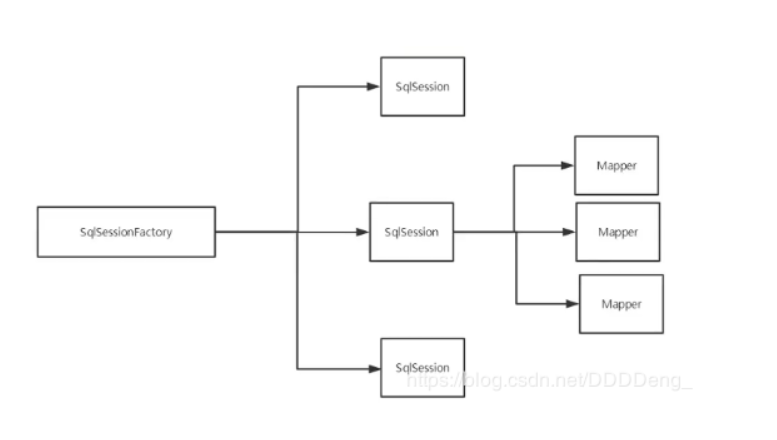
4、解决属性名和字段名不一致的问题
1. 问题
数据库中的字段

实体类字段
public class User {
private int id;
private String name;
private String pwd;
}
<select id="queryUserById" parameterType="int" resultType="user">
select * from mybatis.user where id = #{user.id}
</select>
上面这个类有 3 个属性:id,name 和 pwd。这些属性会对应到 select 语句中的列名。这些属性会对应到 select 语句中的列名。但是类的名字和数据库的字段要一致。这样的一个 JavaBean 可以被映射到 ResultSet
上面案例中,pwd和password不同所以测试结果显示pwd为null

解决方法:
-
起别名
<select id="getUserById" resultType="com.kuang.pojo.User"> select id,name,password as pwd from USER where id = #{id} </select>MyBatis 会在幕后自动创建一个
ResultMap,再根据属性名来映射列到 JavaBean 的属性上。如果列名和属性名不能匹配上,可以在 SELECT 语句中设置列别名(这是一个基本的 SQL 特性)来完成匹配
2. resultMap
结果集映射
<resultMap id="resultMap" type="user">
<result column="password" property="pwd"/>
</resultMap>
<select id="queryUserById" parameterType="int" resultMap="resultMap">
#也可以省去对象名称
select * from mybatis.user where id = #{user.id}
</select>
resultMap元素是 MyBatis 中最重要最强大的元素。- ResultMap 的设计思想是,对简单的语句做到零配置,对于复杂一点的语句,只需要描述语句之间的关系就行了。
ResultMap的优秀之处——你完全可以不用显式地配置它们。
5. 日志

掌握 stdout_logging,log4j
5.1 STDOUT_LOGGING
在mybatis_config.xml文件中添加设置
<settings>
<setting name="logImpl" value="STDOUT_LOGGING"/>
</settings>
测试结果
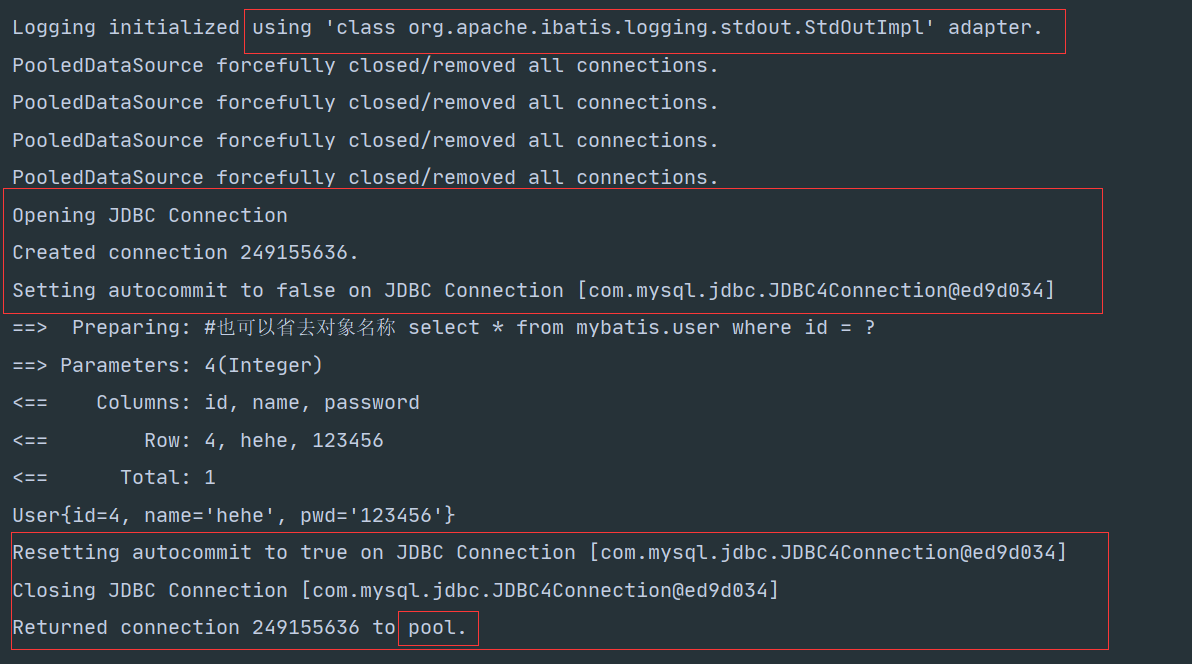
5.2 LOG4J
简介
Log4j是Apache的一个开源项目,通过使用Log4j,我们可以控制日志信息输送的目的地是控制台、文件、GUI组件,甚至是套接口服务器、NT的事件记录器、UNIX Syslog守护进程等;我们也可以控制每一条日志的输出格式;通过定义每一条日志信息的级别,我们能够更加细致地控制日志的生成过程。最令人感兴趣的就是,这些可以通过一个配置文件来灵活地进行配置,而不需要修改应用的代码。
代码测试
-
添加设置
<settings> <setting name="logImpl" value="LOG4J"/> </settings> -
导入log4j的依赖包
<dependency> <groupId>log4j</groupId> <artifactId>log4j</artifactId> <version>1.2.17</version> </dependency> -
编写log4j.properties
#将等级为DEBUG的日志信息输出到console和file这两个目的地,console和file的定义在下面的代码 log4j.rootLogger=DEBUG,console,file #控制台输出的相关设置 log4j.appender.console = org.apache.log4j.ConsoleAppender log4j.appender.console.Target = System.out log4j.appender.console.Threshold=DEBUG log4j.appender.console.layout = org.apache.log4j.PatternLayout log4j.appender.console.layout.ConversionPattern=[%c]-%m%n #文件输出的相关设置 log4j.appender.file = org.apache.log4j.RollingFileAppender log4j.appender.file.File=./log/rzp.log log4j.appender.file.MaxFileSize=10mb log4j.appender.file.Threshold=DEBUG log4j.appender.file.layout=org.apache.log4j.PatternLayout log4j.appender.file.layout.ConversionPattern=[%p][%d{yy-MM-dd}][%c]%m%n #日志输出级别 log4j.logger.org.mybatis=DEBUG log4j.logger.java.sql=DEBUG log4j.logger.java.sql.Statement=DEBUG log4j.logger.java.sql.ResultSet=DEBUG log4j.logger.java.sq1.PreparedStatement=DEBUG -
测试结果
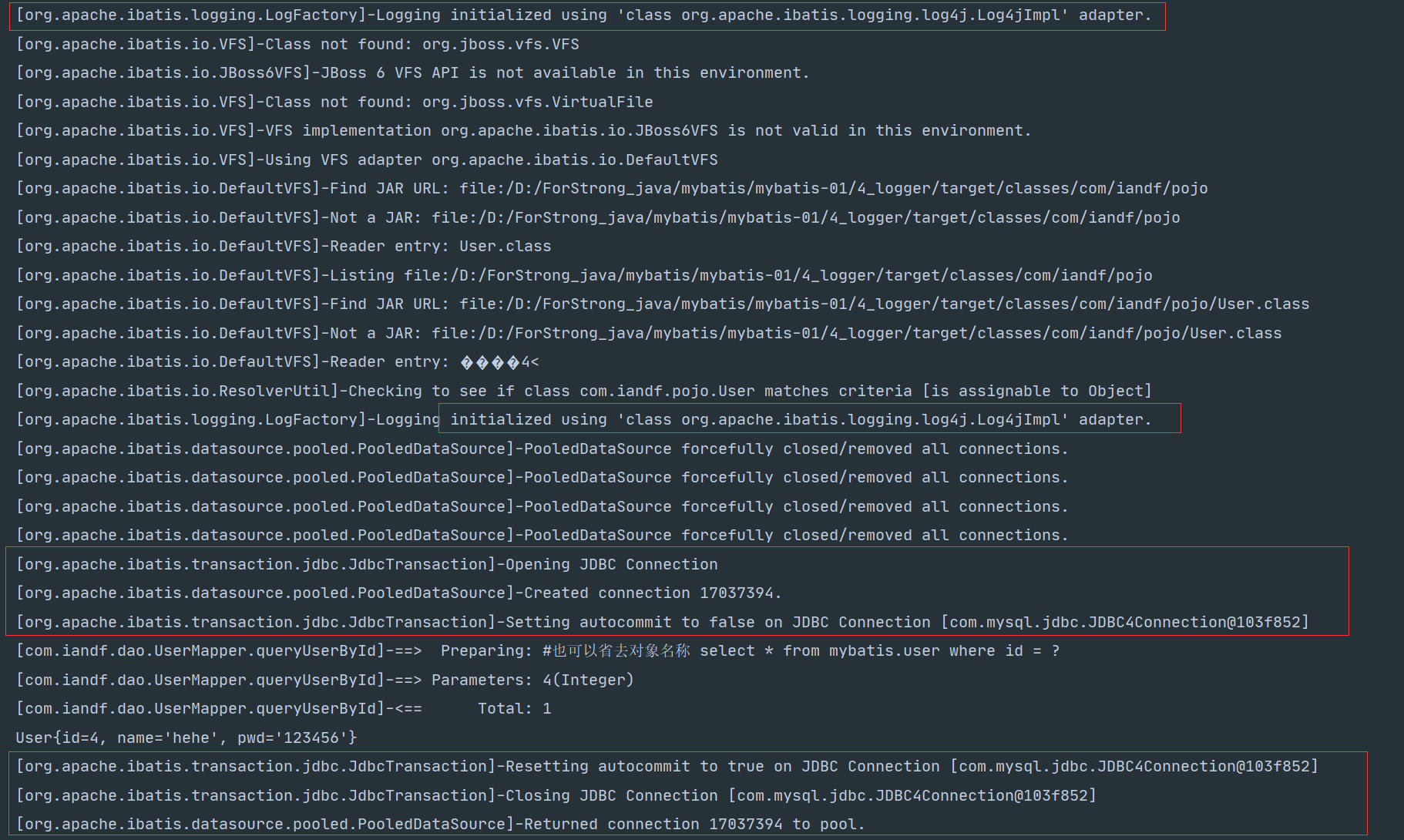
-
简单使用
Logger logger = Logger.getLogger(UserDaoTest.class); logger.debug("debug"); logger.error("error"); logger.info("info");
6. Mybatis的执行流程
-
创建SqlSessionFactoryBuilder
-
使用建造者模式构建SqlSessionFactory
-
源码解析,使用配置文件的输入流构建一个XMLConfigBuilder对象,使用XMLConfigBuilder为参数构建DefaultSqlSessionFactory
public SqlSessionFactory build(InputStream inputStream, String environment, Properties properties) { SqlSessionFactory var5; try { XMLConfigBuilder parser = new XMLConfigBuilder(inputStream, environment, properties); var5 = this.build(parser.parse()); } catch (Exception var14) { .... } return var5; } public SqlSessionFactory build(Configuration config) { return new DefaultSqlSessionFactory(config); } -
执行结果

-
使用SqlSessionFactory创建sqlSession对象
-
源码分析,使用使用transaction作为参数生成了executor,configuration,executor生成了sqlSession
private SqlSession openSessionFromDataSource(ExecutorType execType, TransactionIsolationLevel level, boolean autoCommit) { Transaction tx = null; DefaultSqlSession var8; try { Environment environment = this.configuration.getEnvironment(); TransactionFactory transactionFactory = this.getTransactionFactoryFromEnvironment(environment); tx = transactionFactory.newTransaction(environment.getDataSource(), level, autoCommit); Executor executor = this.configuration.newExecutor(tx, execType); var8 = new DefaultSqlSession(this.configuration, executor, autoCommit); } catch (Exception var12) { ... } return var8; } -
执行结果

-
-
实现CRUD
-
NOTE:
- mybatis执行流程使用了大量的反射,例如它使用反射知道我们所返回的类型是列表
- 使用了建造者和工厂设计模式
流程图如下:
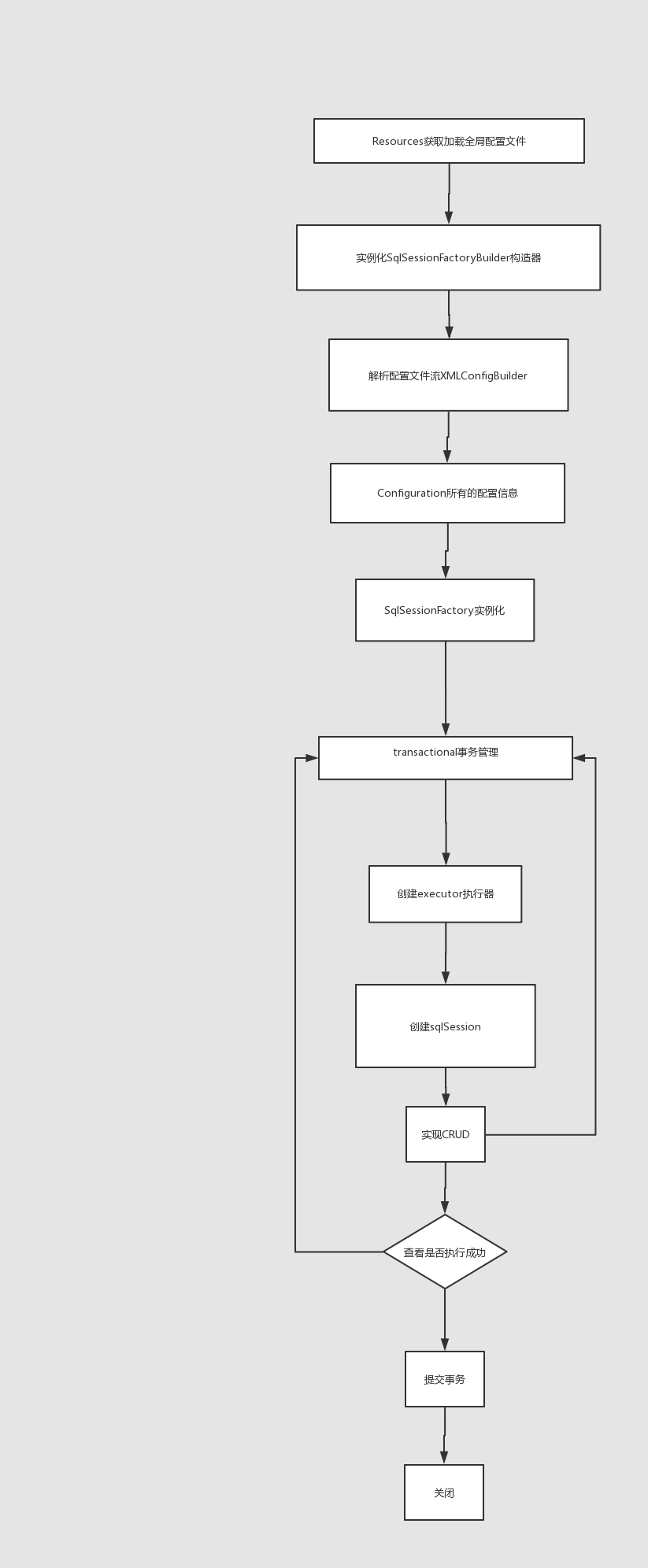
7. 使用注解执行CRUD
-
mapper接口
-
//login @Select("select * from mybatis.user where name=#{name} and password = #{pwd}") User login(@Param("name") String name, @Param("pwd") String password);
-
-
使用class=xxx编写mybatis_configuration.xml文件
<mappers> <!--<mapper resource="com/iandf/dao/UserDaoMapper.xml"/>--> <mapper class="com.iandf.dao.UserMapper"/> </mappers> -
测试
关于@param("xxx")注解:
- 基本类型和String都要加上,引用类型没必要加
- 在sql引用上使用的就是param的属性名
- 基本类型只有一个的时候可以加也可以不加,建议都加上
8. 负责查询语句
8.1 多对一连表查询
查询语句 (查询学生和学生对应的老师的信息)
select s.id, s.name ,t.name from student s,teacher t where s.tid = t.id;
程序实现
1.按照查询嵌套实现
-
mapper接口
-
mapper.xml
<select id="getStudentList" resultMap="studentMap"> select * from mybatis.student </select> <resultMap id="studentMap" type="com.iandf.pojo.Student"> <association property="teacher" column="tid" javaType="com.iandf.pojo.Teacher" select="getTeacher"/> </resultMap> <select id="getTeacher" resultType="teacher"> ##{id}中的名字可以随便取,他的值就是列名为column="tid"的值 select * from mybatis.teacher where id = #{id} </select> -
测试代码
- 按照结果嵌套的方式实现
-
mapper接口
-
mapper.xml
<select id="getStudentList2" resultMap="studentMap2"> select s.id sId, s.name sName, t.name tName, t.id tId from mybatis.student s, mybatis.teacher t where s.tid = t.id; </select> <resultMap id="studentMap2" type="student"> <result property="id" column="sID"/> <result property="name" column="sName"/> <association property="teacher" javaType="Teacher"> <result property="id" column="tID"/> <result property="name" column="tName"/> </association> </resultMap> -
测试代码
8.2 一对多连表查询
查询老师和老师交的所有学生
select t.id tId ,t.name tName,s.id sId, s.name sName from mybatis.student s,mybatis.teacher t where s.tid = t.id and t.id = 1;
按照结果嵌套方式实现
-
mapper接口
-
mapper.xml
<select id="getTeacherInfoById" resultMap="teacherMap" parameterType="int"> select t.id tId ,t.name tName,s.id sId, s.name sName from mybatis.student s,mybatis.teacher t where s.tid = t.id and t.id = #{id}; </select> <resultMap id="teacherMap" type="teacher"> <result column="tId" property="id"/> <result column="tName" property="name"/> <collection property="students" ofType="student"> <result property="id" column="sId"/> <result property="name" column="sName"/> </collection> </resultMap> -
测试代码
按照查询嵌套方式实现
mapper.xml
<select id="getTeacherInfoById2" resultMap="teacherMap2" parameterType="int">
select * from mybatis.teacher
</select>
<resultMap id="teacherMap2" type="teacher">
<collection property="students" column="id" ofType="Student" select="getStudents"/>
</resultMap>
<select id="getStudents" resultType="student">
select * from mybatis.student where tid = #{id}
</select>
8.3 总结
多对一使用association
association – 一个复杂类型的关联;许多结果将包装成这种类型
- 嵌套结果映射 – 关联可以是
resultMap元素,或是对其它结果映射的引用
一对多使用collection
collection – 一个复杂类型的集合
- 嵌套结果映射 – 集合可以是
resultMap元素,或是对其它结果映射的引用 - ofType代表集合的泛型 javaType指的是实体类中的类型
9. 动态SQL
9.1 简介
动态 SQL 是 MyBatis 的强大特性之一。如果你使用过 JDBC 或其它类似的框架,你应该能理解根据不同条件拼接 SQL 语句有多痛苦,例如拼接时要确保不能忘记添加必要的空格,还要注意去掉列表最后一个列名的逗号。利用动态 SQL,可以彻底摆脱这种痛苦。
使用动态 SQL 并非一件易事,但借助可用于任何 SQL 映射语句中的强大的动态 SQL 语言,MyBatis 显著地提升了这一特性的易用性。
- if
- choose (when, otherwise)
- trim (where, set)
- foreach
9.2 IF
需求:根据作者名字和博客名字来查询博客!如果作者名字为空,那么只根据博客名字查询,反之,则根据作者名来查询
-
mapper接口
List<Blog> queryBlogByIf(Map<String,String> map); -
mapper.xml
<select id="queryBlogByIf" parameterType="map" resultType="Blog"> select * from mybatis.blog where 1=1 <if test="title != null"> and title = #{title} </if> <if test="author != null"> and author = #{author} </if> </select> -
测试
1=1在项目中是不允许这样使用的,mybatis为我们提供了where标签来解决and或者or加不加的问题
改进后:
<select id="queryBlogByIf" parameterType="map" resultType="Blog">
select * from mybatis.blog
<where>
<if test="title != null">
and title = #{title}
</if>
<if test="author != null">
and author = #{author}
</if>
</where>
</select>
这个“where”标签会知道如果它包含的标签中有返回值的话,它就插入一个‘where’。此外,如果标签返回的内容是以AND 或OR 开头的,则它会剔除掉。
9.3 set
同理,上面的对于查询 SQL 语句包含 where 关键字,如果在进行更新操作的时候,含有 set 关键词,我们怎么处理呢?
需求:修改博客的title或者author
-
mapper接口
void updateBlogBySet(Map<String,String> map); -
mapper.xml
<update id="updateBlogBySet" parameterType="map"> update mybatis.blog <set> <if test="title != null"> title = #{title}, </if> <if test="author != null"> author = #{author} </if> </set> where id = #{id} </update> -
测试
9.4 choose、when、otherwise
有时候,我们不想使用所有的条件,而只是想从多个条件中选择一个使用。针对这种情况,MyBatis 提供了 choose 元素,它有点像 Java 中的 switch 语句。
需求:传入了 “title” 就按 “title” 查找,传入了 “author” 就按 “author” 查找的情形。若两者都没有传入,就返回所有的 BLOG
-
mapper接口
List<Blog> queryBlogByChoose(Map<String,String> map); -
mapper.xml
<select id="queryBlogByChoose" parameterType="map" resultType="blog"> select * from mybatis.blog <where> <choose> <when test="title != null"> title = #{title} </when> <when test="author != null"> and author = #{author} </when> </choose> </where> </select> -
测试
9.5 sql片段
有时候可能某个 sql 语句我们用的特别多,为了增加代码的重用性,简化代码,我们需要将这些代码抽取出来,然后使用时直接调用。
提取sql片段
<sql id="if-title-author">
<if test="title != null">
and title = #{title}
</if>
<if test="author != null">
and author = #{author}
</if>
</sql>
引用sql片段
<select id="queryBlogByIf" parameterType="map" resultType="Blog">
select * from mybatis.blog
<where>
<include refid="if-title-author"/>
<!-- 在这里还可以引用其他的 sql 片段 -->
</where>
</select>
NOTE:
- 最好是基于单表查询,可以提高片段的可重用性
- sql片段中不要包含where,最好只有几个简单的if
9.6 foreach
需求:我们需要查询 blog 表中 id 分别为1,2,3的博客信息
sql语句
select * from blog where id in (1,2,3);
代码实现
-
mapper接口
List<Blog> queryBlogByForeach(Map<String,Object> map); -
mapper.xml
<select id="queryBlogByForeach" resultType="blog" parameterType="map"> select * from mybatis.blog <where> <foreach collection="ids" item="id" open="id in (" close=")" separator=","> #{id} </foreach> </where> </select> -
测试
public void queryBlogByForeach(){ try(SqlSession sqlSession = MybatisUtil.getSqlSession()){ BlogMapper mapper = sqlSession.getMapper(BlogMapper.class); HashMap<String, Object> map = new HashMap<>(); List<Integer> ids = new ArrayList<>(); ids.add(1); ids.add(2); ids.add(3); map.put("ids",ids); List<Blog> blogs = mapper.queryBlogByForeach(map); for (Blog blog : blogs) { System.out.println(blog.toString()); } } }
10. Mybatis缓存
10.1 简介
查询 : 连接数据库 ,耗资源!
一次查询的结果,给他暂存在一个可以直接取到的地方!--> 内存 : 缓存我们再次查询相同数据的时候,直接走缓存,就不用走数据库了
-
什么是缓存 [ Cache ]?
- 存在内存中的临时数据。
- 将用户经常查询的数据放在缓存(内存)中,用户去查询数据就不用从磁盘上(关系型数据库数据文件)查询,从缓存中查询,从而提高查询效率,解决了高并发系统的性能问题。
-
为什么使用缓存?
- 减少和数据库的交互次数,减少系统开销,提高系统效率。
-
什么样的数据能使用缓存?
- 经常查询并且不经常改变的数据。【可以使用缓存】
10.2、Mybatis缓存
- MyBatis包含一个非常强大的查询缓存特性,它可以非常方便地定制和配置缓存。缓存可以极大的提升查询效率。
- MyBatis系统中默认定义了两级缓存:一级缓存和二级缓存
- 默认情况下,只有一级缓存开启。(SqlSession级别的缓存,也称为本地缓存)
- 二级缓存需要手动开启和配置,他是基于namespace级别的缓存。
- 为了提高扩展性,MyBatis定义了缓存接口Cache。我们可以通过实现Cache接口来自定义二级缓存
10.3、一级缓存
- 一级缓存也叫本地缓存: SqlSession
- 与数据库同一次会话期间查询到的数据会放在本地缓存中。
- 以后如果需要获取相同的数据,直接从缓存中拿,没必须再去查询数据库;
测试步骤:
- 开启日志!
- 测试在一个Sesion中查询两次相同记录
- 查看日志输出
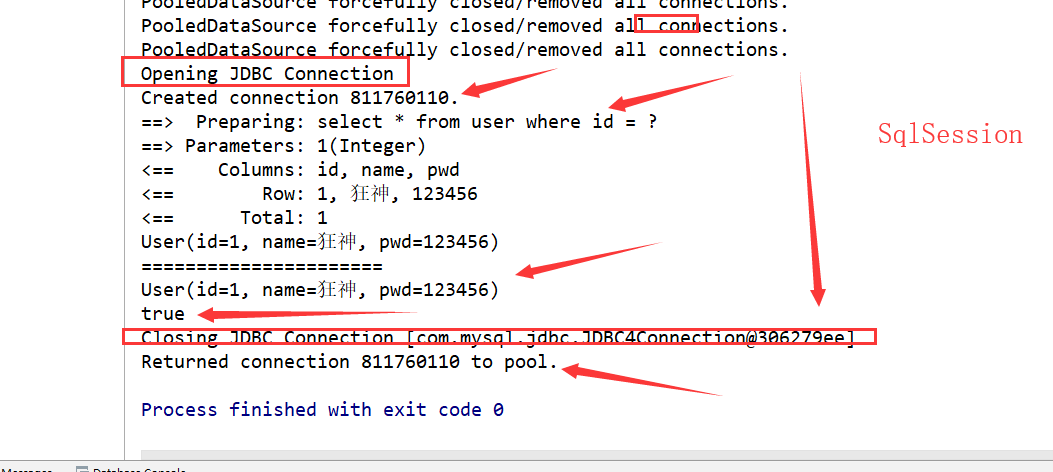
缓存失效的情况:
-
查询不同的东西
-
增删改操作,可能会改变原来的数据,所以必定会刷新缓存!
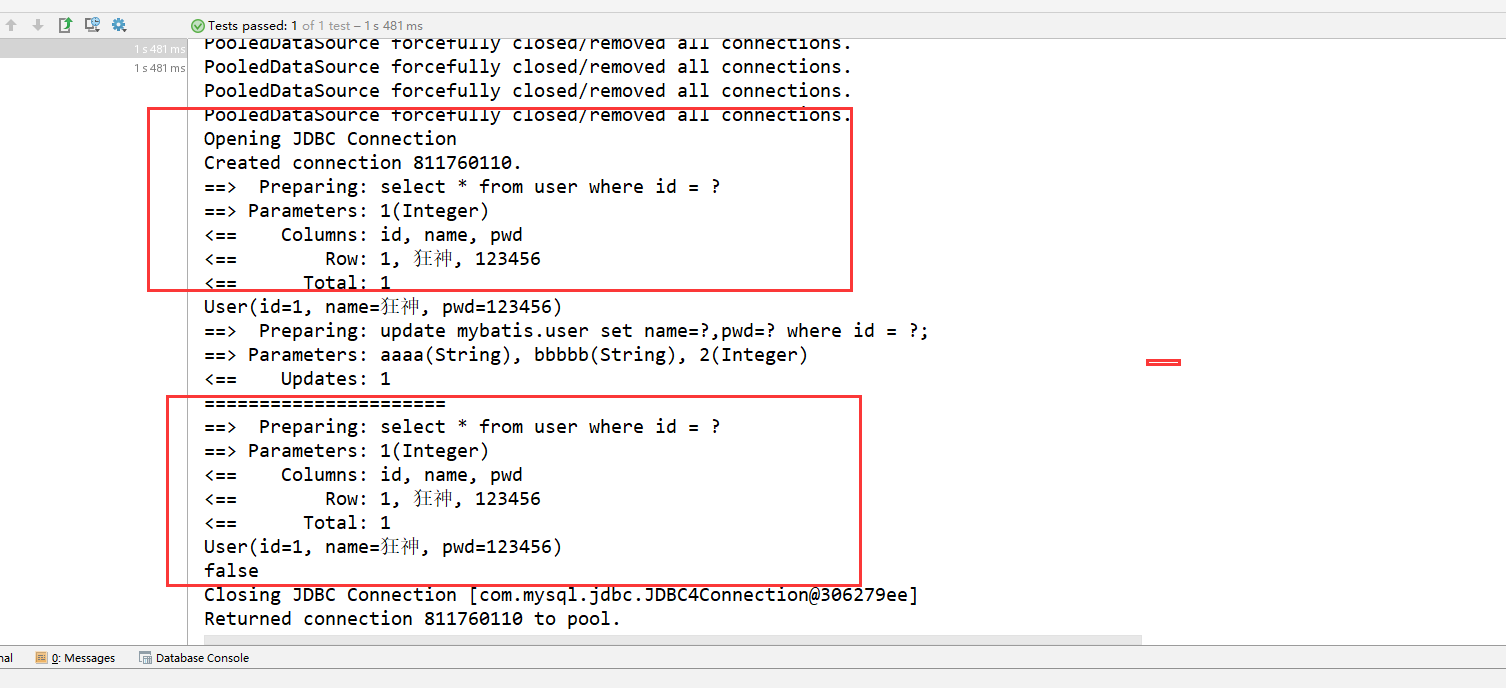
-
查询不同的Mapper.xml
-
手动清理缓存!
sqlsession.clearCache();
小结:一级缓存默认是开启的,只在一次SqlSession中有效,也就是拿到连接到关闭连接这个区间段!
一级缓存就是一个Map。
10.4、二级缓存
- 二级缓存也叫全局缓存,一级缓存作用域太低了,所以诞生了二级缓存
- 基于namespace级别的缓存,一个名称空间,对应一个二级缓存;
- 工作机制
- 一个会话查询一条数据,这个数据就会被放在当前会话的一级缓存中;
- 如果当前会话关闭了,这个会话对应的一级缓存就没了;但是我们想要的是,会话关闭了,一级缓存中的数据被保存到二级缓存中;
- 新的会话查询信息,就可以从二级缓存中获取内容;
- 不同的mapper查出的数据会放在自己对应的缓存(map)中;
步骤:
-
开启全局缓存
<!--显示的开启全局缓存--> <setting name="cacheEnabled" value="true"/> -
在要使用二级缓存的Mapper中开启
<!--在当前Mapper.xml中使用二级缓存--> <cache/>也可以自定义参数
<!--在当前Mapper.xml中使用二级缓存--> <cache eviction="FIFO" flushInterval="60000" size="512" readOnly="true"/> -
测试
-
问题:我们需要将实体类序列化!否则就会报错!
Caused by: java.io.NotSerializableException: com.kuang.pojo.User
-
小结:
- 只要开启了二级缓存,在同一个Mapper下就有效
- 所有的数据都会先放在一级缓存中;
- 只有当会话提交,或者关闭的时候,才会提交到二级缓存中!
10.5、缓存原理
